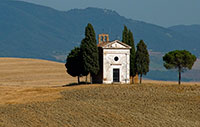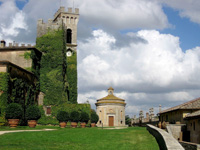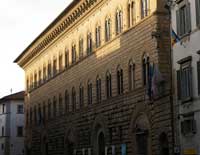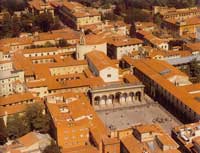| |
|
| |
|
|
|
|
|
|
| |
 |
|
 |
 |
| |
|
|
|
| |
|
Walking in Tuscany | Florence | Quarter Duomo and Signoria Square
|
|
|
|
| |
|
| The first part of the tour includes the Duomo and Piazza della Signoria which are the religious and the civic centre of the town, its heart where all the masterpieces and monuments which made Florence so famous where thought out and made.
Start this tour from Duomo Square, the religious centre of Florence, where the Duomo, the Baptistery, the Bishop palace, Giotto bell tower are located. This part of Florence was inside the ancient walls. The first Cathedral of the town was outside the city walls and it was San Lorenzo Church, this was built in the 4th century; in the VII century the title of “Cathedral” passed to Santa Reparata which in 1296 was rebuilt as Santa Maria del Fiore: the Cathedral we see to day (see description in the section “Churches”). In this period the religious centre was separated from the civic centre with the building of the new civic palace. Palazzo Vecchio (Palazzo della Signoria).
Duomo Square and San Giovanni Square the first with the Cathedral and Giotto Bell tower, and the second with San Giovanni Baptistery, make up the most important religious complex of Florence. Before visiting the single monuments have a walk around the two squares and see the other buildings. On the corner with Via Calzaioli you can see the “loggia del Bigallo” a marble elegant loggia by Ambrogio di Rienzo (1353 – 1358) with large decorated arches and parts of frescoes.
In S. Giovanni Square (behind the Baptistery) is the Bishop Palace by Giovanni Dosio (1573 – 1584). Do not forget to have a look on the back side of the palace in “Piazza dell’Olio” where you can see one of the oldest façades of Florence: the little church of San Salvatore al Vescovo. This façade helps us to understand the Baptistery external covering and the façade of San Miniato. Remember the two of them when you visit the third one so that you can have an organic idea of the Florentine Romanic. Between Via Ricasoli and Via de’ Servi, you can see old houses with stone arches which date back to 15th century: the Strozzi Niccolini Palace where Donatello had his studio (half length portrait). Now we are near the entrance of the Museo dell’Opera del Duomo. Visit it if you have time, but not now. Before visit the Cathedral and the Baptistery because in this museum you’ll see the original works which were in these two buildings. Into the Duomo (Cathedral) you can have a free tour in English by one of the volunteers.
Proceeding around the square near nr 54 (red) you can find a memorial tablet which indicates where Dante’s stone was: a stone where Dante was thought to seat in summer evening to refresh himself. There is a story about this habit of the most important Florentine and Italian poet: once, while he was sitting on the stone, a friend of his asked the poet: “what is the best food for you?” Dante answered: “the boiled egg”. One year later the friend passed again in front of the sitting poet and asked:”How?”, “with some salt!” answered the poet.
In this little square named “Piazza delle Pallottole” you find a nice good restaurant: “Sasso di Dante”.
Going on around the square you’ll find two big statues: Arnolfo (di Cambio) and Brunelleschi. Arnolfo di Cambio was the architect who in 1296 built the cathedral and Brunelleschi was the one who built the dome. A little further on there is the seat of the Arciconfraternita della Misericordia, founded by S. Pietro Martire in 1244 to give assistance to the invalid and sick people and to bury the poor dead people (this institution was the precursor of the modern ambulance rescues and it is still working very well). Have a look inside.Now you can start your visit of the Baptistery: first outside and then inside (see churches section for the description) and later of the Cathedral. In the square there are many bars and restaurant, to rest and have a good coffee or cappuccino.
If you like you can also climb on the dome or on Giotto bell tower. I prefere the dome (463 steps) because it is a little higher thank the bell tower (414 easy steps); the panorama is almost the same but you can visit the dome both outside and inside so that you can admire the frescoes by Vasari and Zuccari very close (see “churches” section).
Now it is time for you to visit the museum (Museo dell’Opera del Duomo) but first have a look in Via dello Studio a little street from Duomo Square. Here in a little building at the corner with Via della Canonica is the seat of the Opera del Duomo. This foundation was born together with the cathedral and, since 1296, it follows the works of everything concerning the church: projects, building, restoring and so on. You are not allowed to enter, but you can have a look from the glass door, for sure somebody is working to restore pieces of the Cathedral.
The logo of this foundation is OPA, the contraction of the Latin word OPERA: the symbol P has a double value as R an P. In many place inside the Cathedral and outside you can see this logo. The description of the Museum is in “museums” section.
|
|
|
|
| |
|
|
|
|
Piazza della Signoria – Uffizi
|
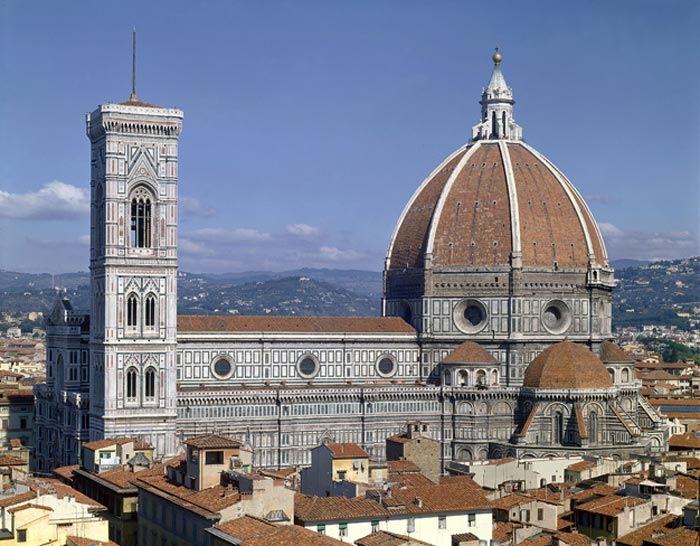 |
Florence | Duomo, the Basilica di Santa Maria dell Fiore
|
|
The civic centre of Florence dates back to the second half of the 13th century. What we see today is only one part of the square which changed several times during the centuries. As in many Tuscan cities the public palaces were several not only one. In a few years they built the Bargello palace (the palace of the People’s Captain) and the Priori palace, which is Palazzo della Signoria also named Palazzo Vecchio, which was planned to give the town a symmetric civic centre with the religious one.
In 1540 Cosimo the 1st Medici moved his residence from Medici Palace in Via Cavour (once Via Larga) to the Signoria Palace, which, when the Medici Family moved again to Pitti palace (1565), was called Palazzo Vecchio (The old palace)
If you start the visit coming from Duomo Square, you can walk along Via Calzaioli, this street was enlarged in 1841/44 in the part which goes from the Duomo to Via Condotta. It has always been a commercial street, but once is was full of shoes shops (Calzaioli = shoe makers), now it has plenty of pizzerie (on my opinion expensive and not very good) and the old fascinating shops are gone.
The most important monuments in this street are: San Carlo de’ Lombardi on your left (by Neri di Fioravante and Benci di Lione) – 1349). In front of it the impressive building of Orsanmichele one of the most interesting buildings of the 14th century in Florence.
In 1290 Arnolfo di Cambio (the same architect of Duomo and Palazzo Vecchio), built a loggia for the wheat market, in 1304 a fire destroyed the loggi, it was rebuilt in 1337 (Francesco Talenti and Neri di Fioravante).
A few steps and you are in Piazza della Signoria. In front of you the Old Palace.
In the square we start our tour from the equestrian monument of Cosimo the 1st Medici made in bronze by Giambologna (1594/98)
Also in bronze the bas relieves of the base representing parts of Florentine history.
Near the corner of Palazzo Vecchio the Neptune fountain by Bartolomeo Ammannati (1563-65).
This fountain was built to celebrate the building of a new waterworks . The big imagine of Neptune – the God of the oceans – is not very interesting; much more beautiful are the bronze statues around the fountain.
On the left hand on the steps of the palace you can see the “Marzocco”
one of the heraldic symbols of Florence: a lion with the Florentine lily. Some living lions were kept in a zoo behind the palace along Via de’ Leoni (Lions’ street). The name of Marzocco comes from of Mars, the Latin God of the war, whom, in the Roman period, the town was dedicated to. On the right of the Marzocco a copy of the sculpture Judith and Olofern by Donatello (The original is inside the palace in the “Sala dei Gigli”.
Also the statue of the David by Michelangelo is a copy, the original is in Accademia Museum. This statue was placed here to celebrate the victory of the democracy over the tyranny.
One more sculpture on the right of the palace entrance: “Hercules and Caco “ by Baccio Bandinelli is to celebrate the Medici Family victory over their interior enemies.
|
|
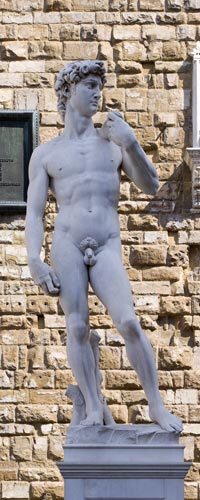
Replica of the David front of Palazzo Vecchio |
The Loggia della Signoria | The Loggia dei Lanzi
|
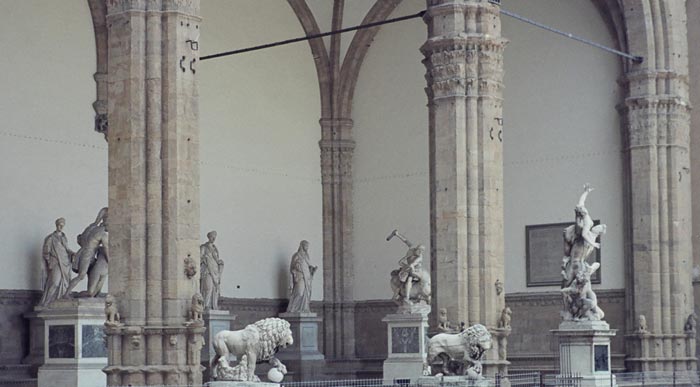 |
| |
On the right there is the elegant and rich “Loggia della Signoria” also named Loggia dell’Orcagna from the nickname of Andrea di Cione who built it (1376/82). This building is also called “Loggia dei Lanzi” Fron the name of the mercenary soldiers who camped here: the lansquenet – lanzichenecchi -.
Cosimo the 1st turned this loggia in a sculpture studio. On the top there are arches and tiles in blue background representing the Cardinal and Theological Virtues.
Under the left arch there is the famous bronze masterpiece by Cellini the “Perseus” (1554) who is showing the Medusa’s cut head.
This sculpture was placed here to front the two masterpieces: The David by Michelangelo and Judith and Olofern by Donatello.
Also of great interest is the marble group “The rape of Sabine women” by Giambologna who gives, with this work, a good specimen of the human body movements. We can have a complete and organic view of the statue from several parts around it.
Now you can start the visit of the Old Palace. If you are not visiting it inside, you can at least have a look around in the first yard to admire the Verrocchio’s putto ( angel).
Aside the Old Palace you find the Uffizi Gallery (see “Museums” section), over it and across the River Arno (by the Old Bridge) the Vasarian Corridor which arrives to Pitti Palace (See “tour along the river”)
Before or after the visit to the palace you can have a nice rest at Revoire’s one of the oldest bars of Florence famous for its chocolate.
Now let’s go on with our tour: on the corner of Via de’ Gondi the palace of the “tribunale di Marcatanzia” where a judge settled the quarrels among the Florentine merchants. Then the Condotta Palace and via de’ Magazzini. The name of Condotta (street an palace) comes from the officers who in this part of Florence, used to pay the soldiers “to conduct” war.
Via de’ Magazzini enlarges in Piazza San Martino with an oratory and a little church (1441). On the corner there is a tabernacle with the image of St Martino giving alms to poors, painted by Cosimo Ulivelli.
Art in Tuscany | The Loggia della Signoria | The Loggia dei Lanzi
|
|
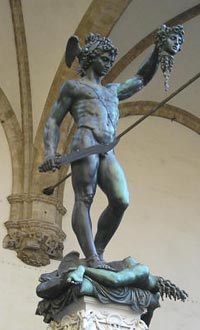
The statue of Perseus by Cellini depicts a decapitation that was intended as a warning to enemies of Cosimo I |
Inside the church the ten lunettes with frescoes of St. Martin’s stories, are very interesting as document of the costume of the time.
On the opposite side of the square there is the ancient façade of the Florentine Badia with the portrait of Ugo di Toscana. On the corner the Torre della Castagna (Chestnut Tower) where the Priors used to meet before the Old Palace was built (1282).
The name comes from the use to put a chestnut into a ballot box to vote a decision. Proceed on the right to meet Dante’s house, this is not the real house of the poet, but a rebuildind of 1921. In the house you can visit a museum. On the left you pass by the little church of Santa Margherita dei Cerchi, the church of Beatrice, Dante’s love (1353). At the end of this little street you are in Via del Corso, the Banca Toscana is now in an beautiful palace: Palazzo Portinari Salviati: once a year you can visit it free on Sunday morning (usually in March or April). One more church here: Santa Maria de’ Ricci (1505) have a look inside and if you like music and concerts read the program of the week, in the evening you can go to hear a concert. Before arriving in Via Calzaioli, turn right in a little street (in front of Coin store corner) after a few steps you are in a nice little square. Here in front of you there is the Pagliazza tower which now is part of Brunelleschi Hotel, but once this building was a jail for women, the name ”Pagliazza” means “palliasse” which was the poor mattress where the prisoner women slept.
Walk around these little streets full of history, of house-towers, of tabernacles and of shops. One of the oldest shops of Florence is Pegna. Set halfway between a supermarket and a luxury food shop, Pegna offers an infinity of delicacies, both Tuscan and international. A grocery store since 1860, Pegna has all the essentials that a grocery store should have.
The old Palazzo Pegna was built in the eighteenth century by a Florentine family of merchants. It is situated in the old Via Faenza - a place where several arts and crafts met in the Middle Ages - and near Porta Faenza, the gate in the fifteenth-century city walls. Porta Faenza was part of the city walls and was situated at the end of what is up till now called Via Faenza. It has been so called not for being placed towards the town in Emilia, but from the name of the Nuns from Faenza, who had their convent in the neighbourhood once. Between 1534 and 1537 Porta Faenza was joined to the Fortezza da Basso without being demolished: by watching attentively you can still distinguish its squared profile in the central bastion towards the city or its arch from the inside of the fortress. |
|
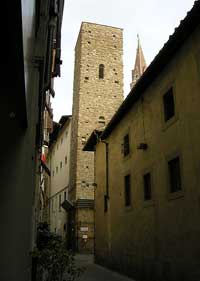 Torre della Castagna (Piazza San Martino) Torre della Castagna (Piazza San Martino)
|
|
|
| |
|

Art in Tuscany | Florence Piazzas | Le piazze di Firenze
Art in Tuscany | Florence | The Duomo of Santa Maria del Fiore
Gianfranco Bracci , The "Renaissance Ring" Trail: Walking and nordic hiking on the hills around Florence
|


Hidden secrets in Tuscany | Podere Santa Pia
|
| |
|
|
|
|
|
|
|
Podere Santa Pia |
|
Podere Santa Pia |
|
Madonna di Vitaleta Chapel, San Quirico d'Orcia
|
| |
|
|
|
|
|
|
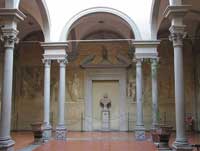
|
Villa Celsa near Florence |
|
Piazza della Santissima Annunziata
in Florence |
|
Choistro dello Scalzo, Florence |
| |
|
|
|
|
|
|
|
|
|
Palazzo Medici Riccardi, Florence |
|
Piazza della Santissima Annunziata
in Florence |
|
Florence, Duomo |
| |
|
|
|
|
Torre della Castagna (Chestnuts Tower), also known as Mouth Iron is one of the ancient towers of the historical center of Florence, among the best preserved, located in Piazza San Martino corner of Via Dante Alighieri. Via Dante Alighieri is named after the famous Florentine poet of the 13th century, of where he resided until his exile. It is this road that he encountered the one love of his life and inspiration, Beatrice.
Near the Torre della Castagna, you will find the Church of San Martino, where Dante married his wife, Gemma Donati. Dante received a thorough education in both classical and Christian literature. At the age of 12 he was promised to his future wife, Gemma Donati. Dante had already fallen in love with another girl whom he called Beatrice. She was 9 years old. Years later Dante met Beatrice again. He had become interested in writing verse, and although he wrote several sonnets to Beatrice, he never mentioned his wife Gemma in any of his poems. One of his early sonnets Dante sent to the poet Guido Cavalcanti, which started their friendship.
Dante also dedicated his first book to Cavalcanti. The work, LA VITA NUOVA (1292), celebrated Dante's love for Beatrice. The nature of his love had its roots in the medieval concept of "courtly love" and the idealization of women. According to another theory, Beatrice was actually a symbol of 'Santa Sapienza', which united secret societies of the day. Harold Bloom in The Western Canon (1994) sees Beatrice as Dante's greatest muse, his invention, who saved him "by giving him his greatest image for poetry, and he saved her from oblivion, little as she may have wanted such salvation."
Dante married in 1285 Gemma Donati but his ideal lady and inspiration for his poetry was Beatrice Portinari. She married Simone dei Bardi in 1287; she was his second wife. When Dante was asked why he still continued unhappily to love her, he answered: "Ladies, the end of my love was indeed the greeting of this lady, of whom you are perhaps thinking, and in that greeting lay my beatitude, for it was the end of all my desires. But because it pleased her to deny it to me, my Lord Love in his mercy has placed all my beatitude in that which cannot fail me." Beatrice died in June 1290, at the age of 24. After Beatrice's death, Dante withdrew into intense study and began composing poems dedicated to her memory.
Art in Tuscany | Dante Alighieri
|
|
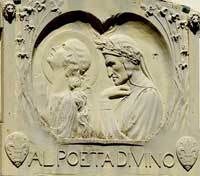 A plaque in the Abbey of Vallombrosa commemorates a visit from Dante A plaque in the Abbey of Vallombrosa commemorates a visit from Dante
|
 |
|
|
Choosing one of the Florence walking tours you'll be able to visit the world-famous museums of the Uffizi and Accademia Galleries, discovering the main historical and artistic treasures of the city.
The tours focus on Florence's major sights and attractions, including the Duomo, the Ponte Vecchio and the city's famous churches and Renaissance palaces.
Novelist Henry James called Florence a “rounded pearl of cities -- cheerful, compact, complete -- full of a delicious mixture of beauty and convenience.” The best way to experience the Italian city’s artistry, history and joy of life is by walking the same paths that the Medicis, Michelangelo and James once used.
1 | A Walk Around the Uffizi Gallery
2 | Quarter Duomo and Signoria Square
3 | Around Piazza della Repubblica
4 | Santa Maria Novella
5 | San Niccolo Neighbourhood in Oltrarno
6 | Walking in the Bargello Neighbourhood
7 | From Fiesole to Settignano |
|
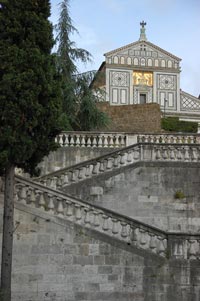
San Miniato al Monte |
|
|
| |
|
|
|
| |
|
|
|
| |
|
|
|
| |
|
|
|
| |
|
|
|
| |
|
|
|







 Torre della Castagna (Piazza San Martino)
Torre della Castagna (Piazza San Martino)

